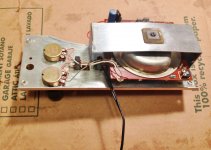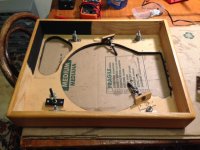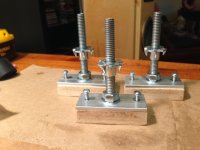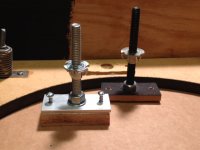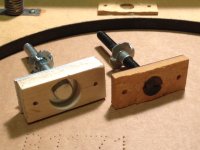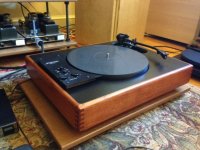Hey there guys. I just picked up an older Sota Sapphire from the 80s off that auction site that had "speed issues". Got it in the mail the other day and it was in pretty rough shape. The cord that attaches to the motor controls was partially detached. The bottom chassis is also made of MDF, so anywhere there was a load bearing bolt or screw that was stressed, it's busted.
The chassis is another issue I'll address in time, but I re-soldered the wires to the area of the switch and replaced a cap (with the matching value) that was out of spec. Fired it up and have a very "rough" sounding motor. There is some light scraping as if the pulley shaft is out of alignment, and the whole motor seems to shudder every now and then. It uses a Pabst motor (the "pancake" kind, I believe) with what seems to be a lead screw in the bottom of the thing that is as soft as butter.
I haven't thoroughly checked the 20 or so resistors on the board, but before I go on and potentially destroy it, I wanted to ask has anyone ever attempt to service one of these motors or encountered any problems they resolved? Any pointers would be appreciated.
The chassis is another issue I'll address in time, but I re-soldered the wires to the area of the switch and replaced a cap (with the matching value) that was out of spec. Fired it up and have a very "rough" sounding motor. There is some light scraping as if the pulley shaft is out of alignment, and the whole motor seems to shudder every now and then. It uses a Pabst motor (the "pancake" kind, I believe) with what seems to be a lead screw in the bottom of the thing that is as soft as butter.
I haven't thoroughly checked the 20 or so resistors on the board, but before I go on and potentially destroy it, I wanted to ask has anyone ever attempt to service one of these motors or encountered any problems they resolved? Any pointers would be appreciated.
Attachments
Put a drop of Acetone on the slotted screw and wait a little, then start moving the screw back and forth to get it moving
You would adjust in if you hear a scraping noise.
I did this to one that was in bad shape also.
The up and down free play was too much on mine compared to 2 other SOTA,s I have.
This model is a early version without the cast metal housing of later versions. ( note the u shaped aluminum bracket )
If I get time, I will check the free up and down play with a dial indicator on the newer versions so you can get it close
Turning it in will get you started.
Regards
David
You would adjust in if you hear a scraping noise.
I did this to one that was in bad shape also.
The up and down free play was too much on mine compared to 2 other SOTA,s I have.
This model is a early version without the cast metal housing of later versions. ( note the u shaped aluminum bracket )
If I get time, I will check the free up and down play with a dial indicator on the newer versions so you can get it close
Turning it in will get you started.
Regards
David
Thanks for the response David. I managed to get that screw out from the bottom and peek inside the motor. With the pulley shaft inserted, I could see that it was pulling the lower bushing out of center causing the rubbing/scraping I heard.
I realigned it by sight, put a new set screw in, and turned it on. There was still a little rubbing so with a little sideways pressure on the spinning pulley, I was able to push it into better alignment. It is as quiet as a mouse now, and even with a stethoscope, I can barely hear resonance on the aluminum bracket.
I'd still like to know how much play I should have. If you get a chance to measure it, let me know.
Also, attached is a photo of the "upper" plinth. You can clearly see the coupling bolts have broken out of the MDF housing and were completely free. Over the weekend I put some together with hardwood and aluminum plate. I'm not sure if you can see the bottom, but the hex head bolt goes through a washer. Only thing that will give out now would be the screws holding it in place, but I figure it'll be good to go for another 30 years.
I realigned it by sight, put a new set screw in, and turned it on. There was still a little rubbing so with a little sideways pressure on the spinning pulley, I was able to push it into better alignment. It is as quiet as a mouse now, and even with a stethoscope, I can barely hear resonance on the aluminum bracket.
I'd still like to know how much play I should have. If you get a chance to measure it, let me know.
Also, attached is a photo of the "upper" plinth. You can clearly see the coupling bolts have broken out of the MDF housing and were completely free. Over the weekend I put some together with hardwood and aluminum plate. I'm not sure if you can see the bottom, but the hex head bolt goes through a washer. Only thing that will give out now would be the screws holding it in place, but I figure it'll be good to go for another 30 years.
Attachments
Well, maybe I spoke too soon. (There's a chance I had my stereo up too loud.) The noise is still there. The shaft is now centered and everything in alignment but I still have some friction with the shaft that causes the scrape.
Yesterday, I noticed if I turn the motor assembly upside down, the pulley shaft moves down (away from the bronze bushing) due to the vertical play, and the noise completely disappears. Question is, how did you adjust the vertical play, David? Adjustment of that set screw doesn't do much at all.
And is this thing supposed to have a thrust plate? I read a forum on a HK ST-7 that uses the same Papst 38.09, and some guys were talking about a thrust plate. There is no evidence of one in my motor. I can back that set screw out completely and see the bottom of the shaft.
FM
Yesterday, I noticed if I turn the motor assembly upside down, the pulley shaft moves down (away from the bronze bushing) due to the vertical play, and the noise completely disappears. Question is, how did you adjust the vertical play, David? Adjustment of that set screw doesn't do much at all.
And is this thing supposed to have a thrust plate? I read a forum on a HK ST-7 that uses the same Papst 38.09, and some guys were talking about a thrust plate. There is no evidence of one in my motor. I can back that set screw out completely and see the bottom of the shaft.
FM
Got it! A little trial and error and I was able to eliminate the noise. It seems the pulley shaft wasn't seated well. With a little coaxing, and a "tightening" of that set screw, the problem was solved. Speed appears constant and the friction is gone.
I know this isn't a woodworking forum but the Sota came with a light, honey oak plinth that had virtually no depth of color or character. It's good wood with some potential so I sanded it down and toned the wood with General Finishes Vintage Cherry dye diluted 1:1 with water. I've sealed with two thin coats of shellac and it's now a gorgeous dark amber. I'll rub a dark stain into it next to see if I can get the grain to pop a little, seal it, and I'll post a photo or two. Next step is just to put it all back together. It might be a keeper.
I know this isn't a woodworking forum but the Sota came with a light, honey oak plinth that had virtually no depth of color or character. It's good wood with some potential so I sanded it down and toned the wood with General Finishes Vintage Cherry dye diluted 1:1 with water. I've sealed with two thin coats of shellac and it's now a gorgeous dark amber. I'll rub a dark stain into it next to see if I can get the grain to pop a little, seal it, and I'll post a photo or two. Next step is just to put it all back together. It might be a keeper.
Got the Sota all pretty and put back together. I set it up to test the sound, thinking that was that, but alas, it runs fast. And I don't mean 33.6 RPM, I mean breakneck speed--like you could put a mound of clay on there and throw a pot. The motor is very quiet now, but obviously it really does have "speed issues".
I replaced the old electrolytic cap on the board, so I'm guessing it is one of the handful of resistors. Anyone have any ideas?
I replaced the old electrolytic cap on the board, so I'm guessing it is one of the handful of resistors. Anyone have any ideas?
Attachments
I took the motor back out and found quite a few resistors out of spec. I had to make an order from Mouser, so went ahead and got 1% tolerance replacements for most of the resistors as well as a voltage regulator--all for around five bucks. I'll post results when I get a chance to do the job.
Sota Sapphire motor board- Resistor values?
Hi- Do you have the parts list still for the motor board? Would love to know the values of all the parts you replaced. Do you have a schematic?
Thanks! -Wyndham
Success. The new resistors did the trick and speed is dead on. Thanks again for the input.
Hi- Do you have the parts list still for the motor board? Would love to know the values of all the parts you replaced. Do you have a schematic?
Thanks! -Wyndham
- Status
- This old topic is closed. If you want to reopen this topic, contact a moderator using the "Report Post" button.
- Home
- Source & Line
- Analogue Source
- Sota Sapphire rebuild and motor issues
